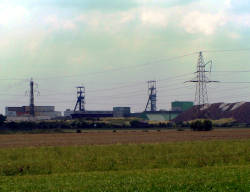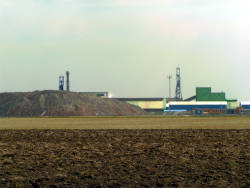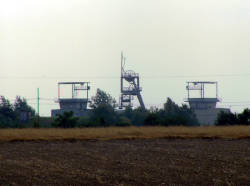Kopalni Soli "Kłodawa"
Klodawa Salt Mine
Useful Information



| Location: |
62-650 Kłodawa, Aleja 1000-lecia 2.
(52.240556, 18.922570) |
| Open: |
Currently closed. All year Mon-Fri 9:15, 10, 14:30. [2023] |
| Fee: |
Adults PLZ 80, Children (7-) PLZ 60, Students (-26) PLN 60, Seniors (65+) PLN 70. [2023] |
| Classification: |
 Salt Mine Salt Mine
|
| Light: |
 Electric Light Electric Light
|
| Dimension: | L=400 km, VR=625 m, T=20 °C. |
| Guided tours: |
D=2.5 h, MinAge=7.



|
| Photography: | allowed |
| Accessibility: | no |
| Bibliography: |
Piotr Krzywiec (2012):
Mesozoic and Cenozoic evolution of salt structures within: The Polish Basin: An overview
Geological Society London Special Publications. 363. 381-394.
researchgate
DOI
Piotr Krzywiec (2004): Triassic evolution of the Kłodawa salt structure: basement-controlled salt tectonics within the Mid-Polish Trough (Central Poland) Geological Quarterly, 2004, Vol. 48, No 2, pp 123-134. online |
| Address: |
Salt Mine „Kłodawa” S.A., 62-650 Kłodawa, Aleja 1000-lecia 2, Tel: +48-632-733-242.
E-mail: |
| As far as we know this information was accurate when it was published (see years in brackets), but may have changed since then. Please check rates and details directly with the companies in question if you need more recent info. |
|
History
| 1939 | Polish professor Edward Walery Janczewski discovered layer of salt between Izbica Kujawska and Solca Wielka. |
| 1946 | The National Oil Search Company starts drilling the first test hole, “Kłodawa 1”, with a depth of 682 m. |
| 1950 to 1954 | first two mineshafts Michał and Barbara built. |
| 1956 | beginning of salt production. |
| 1973 | horses replaced by electric machines. |
| 04-DEC-2004 | show mine opened to the public. |
| 2007 | Kłodawa Underground Tourist Route and selected geological sites listed on the Register of Monuments. |
| 07-SEP-2012 | fire in the mine. |
Geology
The Mid-Polish Trough (MPT) belongs to the system of epicontinental sedimentary basins of Europe. It is of Permian to Cretaceous age, trending northwest to southeast, and filled with several kilometres of siliciclastic and carbonate sediments, resting on a thick Zechstein evaporite sequence. The Zechstein evaporites, mainly anhydrite and salt, are the origin of the dalt deposits, but as they are located at the bottom, between 4 and 6 km deep, they are not mined. Between the Cretaceous and the Palaeocene the downlift was replaced by an uplift, which created numerous fracture zones.
One of them, running parallel to the basin axis, was used by the salt to move upwards along the fractures. This is a result of the lower specific weight of salt, and the possibility to "flow" under high pressure. The result is the Klodawa Zechstein Salt Wall which is 6 km tall, 30 km long, and 2 km wide. During the Triassic the structure evolved from a salt pillow into a diapir. In the latest Triassic the diapir developed an overhang, which was partly squeezed back towards the diapir.
An exceptional feature of the mine is blue halite, or blue rock salt. The colour is very rare and so far it was not possible to explain the origin of the blue pigments. Rock salt is typically colour less or white, sometime reddish. But here blue or violet halite occurs quite frequently.
The origin of the blue color has been investigated for over 150 years by many researchers. One of the first was Kreutz (1892). He made experiments and presented the theory that the color of halite crystals originated from very small admixtures of iron or other metals, which were below the detection limits of analytical methods used at that time. Today a theory says that the color of natural halite results from radiation caused by radioactive decay of 40K isotope. Nevertheless, the origin of blue or violet halite crystals in natural environments has not been adequately explained so far. Experiments which create this colour do not reflect the natural conditions and the physico-chemical properties of artificially colored halite crystals differ from the natural ones.
Description
The visit to Kopalni Soli "Kłodawa" (Klodawa Salt Mine) starts with a 600 m descent down the Michał (Michael) shaft with a mining elevator. With this depth it is the deepest mine tour in Poland. There is a display of machines, the double track mine railway system, and sculptures carved from the salt by miners and artists. Highlight is the underground chapel of St. Kinga. After a tour through various chambers and exhibitions, the visitors return through the same elevator to the surface. In some cases the Barabara shaft is used. The tour is also called Kłodawska Podziemna Trasa Turystyczna (Klodawa Underground Tourist Route). The tour is offered only on working days, which is a little strange, and booking is required. Either make a reservation by phole or use the online booking system.
Michał and Barbara are the first shafts of the mine which were dug in 1950 to 1954. Michał was named after the first director of the mine, Michał Biały, and the other after the patron Saint of the mainers, Saint Barbara. At first the salt was mined with horses, but they were replaced by electric mine trains in 1966. The third shaft Chrobry was named after the first Polish King Bolesław I Chrobry and was drilled 4 km away. It is for ventilation.
The mine was discovered in 1939 by the Polish professor Edward Walery Janczewski. At that time geologists all over the Mesozoic basins used gravimetry to discover salt diapirs and oil deposits. After the war the exact location was determined, and some boreholes produced magnesium-potassium salt. The mine was built with a huge potassium salt processing plant, but in reality there was mostly rock salt with only small amounts of magnesium-potassium salts. The mine was planned to extract 450 thousand tonnes of salt per year and reached this amount after about a decade. In the 1970s it was further expanded and the peak was over 1.2 million tons per year. But the end of the Cold War and the end of the communist system destroyed the old economic system and thus the consumers.
But while the current production is much lower, Kłodawa is still the largest salt producer of Poland. Salt is mined currently in 7 mining fields and on 12 levels at a depth between 322 and 625 m bsl. Salt is mined for the food industry, agriculture, chemical industry and road maintenance during winter.
The mine has an online shop which sells various "unique" salt products. This includes blue salt with a few grains of blue salt in every pack, rock salt in other colours, and even other elements like magnesium, potassium, manganese, and selenium. Some for consumption, others for bathing. The mine also produces great amount of pink or orange rock salt, but despite their statement how unique it is, it is actually quite common. The difference here is that the salt is actually sold in this form, including the kitchy salt lamps, blocks of orange salt with a light bulb inside. This is unique for Europe, most other mines have so far refrained from selling salt the kitchy stuff, though they have no problems selling coloured salt for 200 times its actual worth. The salt lamps from here are identical to the famous himalayan salt lamps, so its possible you will actually get one without knowing.
- See also
 Search DuckDuckGo for "Klodawa Salt Mine"
Search DuckDuckGo for "Klodawa Salt Mine" Google Earth Placemark
Google Earth Placemark Kłodawa Salt Mine - Wikipedia (visited: 04-MAY-2023)
Kłodawa Salt Mine - Wikipedia (visited: 04-MAY-2023) SALT MINE „KŁODAWA” S.A., official website (visited: 04-MAY-2023)
SALT MINE „KŁODAWA” S.A., official website (visited: 04-MAY-2023) Kłodawa Salt Mine (visited: 04-MAY-2023)
Kłodawa Salt Mine (visited: 04-MAY-2023) Kłodawa Salt Mine - ERIH (visited: 04-MAY-2023)
Kłodawa Salt Mine - ERIH (visited: 04-MAY-2023) Halite from Kłodawa salt deposit - mindat.org (visited: 04-MAY-2023)
Halite from Kłodawa salt deposit - mindat.org (visited: 04-MAY-2023)
 Index
Index Topics
Topics Hierarchical
Hierarchical Countries
Countries Maps
Maps